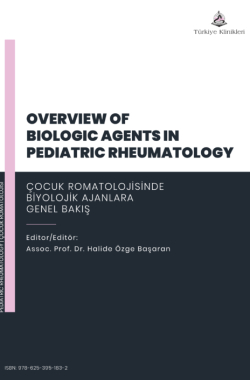Biosimilars in Pediatric Rheumatology
Dilara ÜNALa , Emil ALİYEVa , Yelda BİLGİNERa
aHacettepe University Faculty of Medicine, Department of Pediatric Rheumatology, Ankara, Türkiye
Ünal D, Aliyev E, Bilginer Y. Biosimilars in pediatric rheumatology. In: Başaran HÖ, ed. Overview of Biologic Agents in Pediatric Rheumatology. 1st ed. Ankara: Türkiye Klinikleri; 2024. p.5-9.
ABSTRACT
Targeted biological therapies have become a significant component of treating rheumatic diseases since the introduction of the first tumor necrosis factor (TNF) inhibitor in 1998. The high cost of these products limits many people’s access to them. Introducing biosimilar medications in 2013 may have provided more widespread access to these ”high-cost” medicines. A biosimilar is a legal copy of the ”reference product” or ”bio-originator” that is no longer protected by a patent that has undergone attentive analytical and clinical evaluation in comparison to its reference product and been approved by a regulatory agency according to a predetermined pathway for biosimilars, to ensure that the biosimilar and its biooriginator have equivalent efficacy and highly similar structure and that they have ”no clinically meaningful differences” in pharmacokinetics, efficacy, or safety. A biosimilar must demonstrate ”sameness” as the reference product by demonstrating analytical, pharmacokinetic, and clinical equivalence to the reference product in a series of comparative studies. Biosimilars of tumor necrosis factor inhibitors and rituximab have been approved by regulatory agencies to treat rheumatoid arthritis and other inflammatory diseases and are commercially available in many countries. Other biosimilars of adalimumab, etanercept, infliximab, and rituximab and biosimilars of abatacept, golimumab, and tocilizumab are in development to treat rheumatologic and other inflammatory diseases. Studies on biosimilars in the pediatric age group are limited. There are only studies on adalimumab and etanercept in the pediatric age group. As a result of the studies conducted to date, using biosimilars in pediatric rheumatology is safe and cost-effective. In addition, they have similar and tolerable side effects to generic drugs and can be used by patients. Real-time studies with longer duration and more extensive disease and patient populations are needed for initiation and switching to biosimilar therapy.
Keywords: Biological agents; biosimilars; pediatric rheumatology
Kaynak Göster
Referanslar
- Cuevas OA, Hedrich CM. Biosimilars in pediatric rheumatology and their introduction into routine care. Clinical Immunology. 2020;216:108447. [Crossref] [PubMed]
- Dörner T, Strand V, Cornes P, et al. The changing landscape of biosimilars in rheumatology. Annals of the rheumatic diseases. 2016;75(6):974-82. [Crossref] [PubMed] [PMC]
- Gulacsi L, Brodszky V, Baji P, et al. Biosimilars for the management of rheumatoid arthritis: economic considerations. Expert review of clinical immunology. 2015;11(sup1):43-52. [Crossref] [PubMed]
- Kay J, Schoels MM, Dörner T, et al. Consensus-based recommendations for the use of biosimilars to treat rheumatological diseases. Annals of the rheumatic diseases. 2018;77(2):165-74. [Crossref] [PubMed]
- Putrik P, Ramiro S, Kvien TK, et al. Inequities in access to biologic and synthetic DMARDs across 46 European countries. Annals of the rheumatic diseases. 2014;73(1):198-206. [Crossref] [PubMed]
- U.S. Food and Drug Administration. "Guidance for Industry Scientific Considerations in Demonstrating Biosimilarity to a Reference Product. Department of Health and Human Services, 2015. (cited: Sep 1, 2023). [Link]
- Mellstedt H, Niederwieser D, Ludwig H. The challenge of biosimilars. Ann Oncol. 2008;19(3):411-9. [Crossref] [PubMed]
- McCamish M, Woollett G. The state of the art in the development of biosimilars. Clinical Pharmacology & Therapeutics. 2012;91(3):405-17. [Crossref] [PubMed]
- European Medicines Agency. Guideline on similar biological medicinal products. CHMP/437/04 Rev 1. 2014.
- Grateau G, Hentgen V, Stojanovic KS, Jéru I, Amselem S, Steichen O. How should we approach classification of autoinflammatory diseases? Nature Reviews Rheumatology. 2013;9(10):624-9. [Crossref] [PubMed]
- Herrmann M, Schölmerich J, Straub RH. Stress and rheumatic diseases. Rheumatic Disease Clinics of North America. 2000;26(4):737-63. [Crossref] [PubMed]
- Hochberg MC, Silman AJ, Smolen JS, Weinblatt ME, Weisman MH, Gravallese EM. Rheumatology. Elsevier Health Sciences; 2018.
- Hasseli R, Mueller-Ladner U, Hoyer BF, et al. Older age, comorbidity, glucocorticoid use and disease activity are risk factors for COVID-19 hospitalisation in patients with inflammatory rheumatic and musculoskeletal diseases. Rmd Open. 2021;7(1):e001464. [Crossref] [PubMed] [PMC]
- World Health Organization. Clinical management of COVID-19 - Interim Guidance (May 2020). 2020.
- Annweiler C, Hanotte B, de l'Eprevier CG, Sabatier JM, Lafaie L, Célarier T. Vitamin D and survival in COVID-19 patients: a quasi-experimental study. The Journal of steroid biochemistry and molecular biology. 2020;204:105771. [Crossref] [PubMed] [PMC]
- Jørgensen KK, Olsen IC, Goll GL, et al. Switching from originator infliximab to biosimilar CT-P13 compared with maintained treatment with originator infliximab (NOR-SWITCH): a 52-week, randomised, double-blind, non-inferiority trial. The Lancet. 2017;389(10086):2304-16. [Crossref] [PubMed]
- Schulze-Koops H, Iking-Konert C, Leipe J, et al. Recommendations of the German Society for Rheumatology for management of patients with inflammatory rheumatic diseases in the context of the SARS-CoV-2/COVID-19 pandemic-Update July 2020. Zeitschrift fur Rheumatologie. 2020;79(7):679-85. [Crossref] [PubMed] [PMC]
- Furer V, Rondaan C, Heijstek M, et al. Incidence and prevalence of vaccine preventable infections in adult patients with autoimmune inflammatory rheumatic diseases (AIIRD): a systemic literature review informing the 2019 update of the EULAR recommendations for vaccination in adult patients with AIIRD. RMD open. 2019;5(2):e001041. [Crossref] [PubMed] [PMC]
- Demirkan FG, Ulu K, Öztürk K, et al. Toward the integration of biosimilars into pediatric rheumatology: adalimumab ABP 501 experience of PeRA research group. Expert opinion on biological therapy. 2022;22(2):197-202. [Crossref] [PubMed]
- Ulu K, Çakan M, Çağlayan Ş, et al. Real-life data on efficacy and safety of original Adalimumab and biosimilar Adalimumab (ABP 501) in pediatric rheumatic diseases. Expert opinion on biological therapy. 2023;23(8):833-9. [Crossref] [PubMed]
- Vollbach K, Tenbrock K, Wagner N, et al. Outcome of adult patients with JIA treated with the biosimilar Benepali®: results of the biologic register JuMBO. Arthritis Research & Therapy. 2022;24(1):1-8. [Crossref] [PubMed] [PMC]
- Maccora I, Lombardi N, Crescioli G, et al. OBSIDIAN - real-world evidence of originator to biosimilar drug switch in juvenile idiopathic arthritis. Rheumatology (Oxford, England). Apr 11 2022;61(4):1518-28. [Crossref] [PubMed]
- Food and Drug Administration. Drug Administration Guidance for industry: Scientific considerations in demonstrating biosimilarity to a reference product. Rockville: FDA; 2015.

